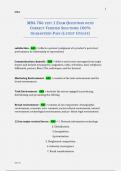1
MBA
MBA 706 TEST 1 EXAM QUESTIONS WITH
CORRECT VERIFIED SOLUTIONS 100%
GUARANTEED PASS (LATEST UPDATE)
satisfaction - ANS ✓reflects a person's judgment of a product's perceived
performance in relationship to expectations
Communication channels - ANS ✓deliver and receive messages from target
buyers and include newspapers, magazines, radio, television, mail, telephone,
billboards, posters, fliers, CDs, audiotapes, and the Internet
Marketing Environment - ANS ✓consists of the task environment and the
broad environment
Task Environment - ANS ✓includes the actors engaged in producing,
distributing, and promoting the offering
Broad environment - ANS ✓consists of six components: demographic
environment, economic envi- ronment, social-cultural environment, natural
environment, technological environment, and po- litical-legal environment.
12 key major societal forces - ANS ✓1. Network information technology
2. Globalization
3.deregulation
4.privatization
5. Heightened competition
6. Industry convergence
7. Retail transformation
MBA 706
, 2
MBA
8. Disintermediation
9. Consumer buying power
10. Consumer information
11. Consumer participation
12. Consumer resistance
New company capabilities - ANS ✓- can use the internet as a powerful
information and sales
channel, including for individually differentiated goods
- can collect fuller and richer information about markets, customers, prospects,
and competitors
- can reach customers quickly and efficiently via social media and mobile
marketing, sending targeted ads, coupons, and information
- can improve purchasing, recruiting, training, and internal and external
communications
- can improve cost efficiency
Marketing planning process - ANS ✓consists of analyzing marketing
opportunities, selecting target markets, designing marketing strategies,
developing marketing programs, and managing the marketing effort.
Companies are increasingly allow- ing customers to customize their products,
such as with personalized messages on the front labels of Heinz ketchup bottles.
eight factors to keep in mind as they create "chaotics marketing strategies -
ANS ✓1. Secure your market share from core customer segments
2. Push aggressively for greater market share from competitors
3. Research customers more now, because their needs and wants are in flux
4. Minimally maintain, but seek to increase, your marketing budget
5. Focus on all that's safe and emphasize core values
6. Drop programs that aren't working for you quickly
7. Don't discount your best brands
MBA 706
, 3
MBA
8. Save the strong; lose the weak
Touch point - ANS ✓where a customer directly or indi- rectly interacts with the
company in some form
Production concept - ANS ✓one of the oldest concepts in business. It holds that
consumers prefer products that are widely available and inexpensive.
Product concept - ANS ✓proposes that consumers favor products offering the
most quality, performance, or innovative features.
Selling Concept - ANS ✓holds that consumers and businesses, if left alone, won't
buy enough of the organization's products
Marketing Concept - ANS ✓emerged in the mid-1950s41 as a customer-
centered, sense-and-respond philosophy. The job is to find not the right
customers for your products, but the right products for your customers
Holistic marketing concept - ANS ✓is based on the development, design, and
implementation of marketing programs, processes, and activities that recognize
their breadth and interdependencies.
Relationship marketing - ANS ✓aims to build mutually satisfying long-term
relationships with key con- stituents in order to earn and retain their business.44
Four key constituents for relationship marketing are customers, employees,
marketing partners (channels, suppliers, distributors, dealers, agencies), and
members of the financial communit
Integrated marketing - ANS ✓occurs when the marketer devises marketing
activities and assembles market- ing programs to create, communicate, and
deliver value for consumers such that "the whole is greater than the sum of its
parts.
MBA 706




